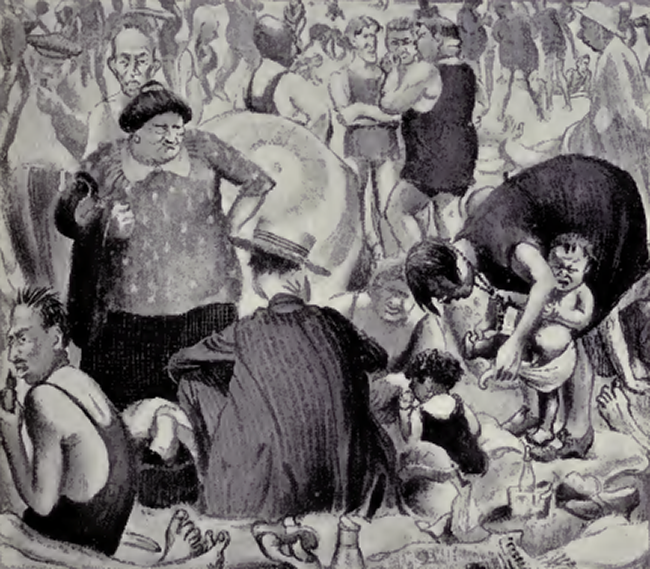
We are celebrating 15 years — and counting — of stories that are deeply researched and deeply felt, that build a historical record of what the city has been.
We are celebrating 15 years — and counting — of stories that are deeply researched and deeply felt, that build a historical record of what the city has been.
With the unofficial start of summer marked by Memorial Day earlier this week, so begins the season of beach-going, travels, and exploration. And inarguably bound up with New York’s conception of summertime is Coney Island — its beach, hotdogs, baseball games, and carnival rides. But beyond the nostalgic image of Coney so familiar to the world lies an interesting lens onto how we use the city and how it’s developed. Earlier this year, Oksana Mironova described the neighborhood west of the iconic Nathan’s, exploring the intertwined questions of housing affordability and storm preparedness facing residents of the area. And currently on view at the Museum of the City of New York, Aaron Rose’s photographs capture the social dynamics and unguarded leisure of our 1960s forbears at the beach.
Last year, I wrote a series of Field Trips on Urban Omnibus revisiting sites documented in the 1939 New York City edition of the Federal Writers’ Project’s (FWP) American Guide Series, among them Floyd Bennett Field, Steinway Village, the Triborough Bridge, and Sunset Park. In the course of delving into the Guide, I found the dynamism and detail in the narrative of Coney Island alluring, the words capturing both the time and the scene. In honor of the start of summertime, read on for an excerpt from that passage and take a look at the Guide‘s accompanying illustrations.

Coney Island | Illustration by Mabel Dwight in New York City Guide: A Comprehensive Guide to the Five Boroughs of the Metropolis (Works Progress Administration, 1939)
Coney entered its present phase when the extension of the subway in 1920 made the beach available to millions of lower-income New Yorkers. The beach was widened, and breakwaters and jetties were constructed for its preservation; in 1921 the boardwalk was opened. A plague of hot-dog stands and cheap amusements followed. Coney Island was now a playground of the people, the “empire of the nickel.”
Summer crowds are the essence of Coney Island. From early morning, when the first throngs pour from the Stillwell Avenue subway terminal, humanity flows over Coney seeking relief from the heat of the city. Italians, Jews, Greeks, Poles, Germans, Negroes, Irish, people of every nationality; boys and girls, feeble ancients, mothers with squirming children, fathers with bundles, push and collide as they rush, laughing, scolding, sweating, for a spot on the sand.
The mass spreads southward in the direction of the beach and boardwalk and the numerous bathhouses. The bathhouses range from large establishments with sports facilities, swimming pools, and restaurants to minute back-yard dressing rooms. One of the largest is the Municipal Baths, Surf Avenue and West Fifth Street, where lockers rent for ten and twenty-five cents each. From the boardwalk the whole beach may be viewed: bathers splash and shout in the turgid waters close to the shore; on the sand, children dig, young men engage in gymnastics and roughhouse each other, or toss balls over the backs of couples lying amorously intertwined. Luncheon combines the difficulties of a picnic with those of a subway rush hour; families sit in wriggling circles consuming food and drinking from thermos bottles brought in suitcases together with bathing suits, spare clothing, and water wings.
A moving throng covers the boardwalk from the outer rail to the food and amusement booths. The air is heavy with mixed odors of frying frankfurters, popcorn, ice cream, cotton candy, corn-on-the-cob, and knishes (Jewish potato cakes). Skee ball, ping pong, beano and other amusements and games of chance are played and watched by hundreds.
After sunset the Island becomes the playground of a mixed crowd of sightseers and strollers. On the Bowery, wedged between Surf Avenue and the boardwalk from Feltman’s to Steeplechase, the shouts of competing barkers become more strident, the crowds more compact. Enormous paintings in primitive colors advertise the freak shows, shooting galleries, and waxworks “Chamber of Horrors.” Riders are whirled, jolted, battered, tossed upside down by the Cyclone, the Thunderbolt, the Mile Sky Chaser, the Loop-o-Plane, the Whip, the Flying Turns, the Dodgem Speedway, the Chute-the-Chutes, and the Comet. Above the cacophony of spielers, cries, and the shrieks and laughter, carrousel organs pound out last year’s tunes, and roller coasters slam down their terriffic inclines. In dance halls and honky-tonks, dancers romp and shuffle to the endless blare of jazz bands.
About midnight, the weary crowds begin to depart, leaving a litter of cigarette butts, torn newspapers, orange and banana peels, old shoes and hats, pop bottles and soiled cardboard boxes, and an occasional corset. A few couples remain behind, with here and there a solitary drunk, or a sleepless old man pacing the boardwalk. The last concessionaire counts his receipts and puts up his shutters, and only the amiable roar of the forgotten sea is heard.
– New York City Guide: A Comprehensive Guide to the Five Boroughs of the Metropolis
(Works Progress Administration, 1939)
The views expressed here are those of the authors only and do not reflect the position of The Architectural League of New York.